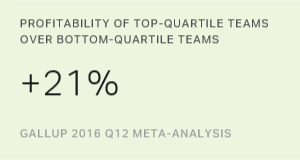Every so often, an idea comes along that, on the surface, seems so compelling and simple that we'd be surprised if it weren't true. Just such an idea -- that there exists a single question that business leaders should ask their customers in order to grow -- has been put forward by Frederick Reichheld.
 |
In essence, Reichheld, a director emeritus of the consulting firm Bain & Company and a Bain Fellow, asserts that the one number a business needs to know and track over time is the percentage of existing customers who would serve as strong advocates for the company. The "net promoter score" (NPS) is calculated by asking customers how likely they would be to recommend the company to others, then sorting them into three categories based on their replies. Reichheld subtracts the percentage of those with the lowest ratings referral intent -- the detractors -- from the percentage of those who are much more likely to recommend the company to others -- the promoters -- to arrive at the company's NPS. (See "The One Number You Need to Grow" in the "See Also" area on this page.)
Reichheld's claim has provoked a great deal of interest and debate, and the utility of the entire construct has recently been called into question (Thurm, 2006). Nonetheless, it has struck a chord, primarily because it takes something that's been considered complex and makes it astonishingly simple. What's more, it holds out the promise that companies just might be able to shed their sometimes cumbersome customer feedback systems in favor of a simple one comprised of just a single question.
The existence of a simple, single-item performance metric that can be reliably linked to positive financial performance would be the management equivalent of a cure for the common cold. But before we all go running off to determine our company's advocacy score on the basis of a single question, consider this: Not all advocates are created equal, nor are they equally valuable. So unless we want to risk being tempted by simplification, we should heed Alfred North Whitehead's sage advice: "Seek simplicity, and distrust it." At a minimum, your shareholders will be glad you did.
First, it is a maxim of measurement theory that single-item measures are inherently less reliable than composite (multi-item) metrics (Crocker & Algina, 1986; Wanous & Hudy, 2001; Wanous, Reichers, & Hudy, 1997). Essentially, that's because a single item may not measure the same things in the same way from one time to the next.
Smart executives should be wary of using one-item indicators for any important business metric, regardless of how simple it might appear. Few of us would be comfortable with a single-item final exam or a single-question job interview. Fortunately, there's an alternative -- a simple performance metric that yields a single number -- but it isn't based on a single item. We'll return to this metric in the section "The four emotional levels."
If your goal is increasing customer advocacy, you need to recognize that the challenge isn't getting customers to talk about a company's products or services. Instead, the challenge is to get them talking positively and passionately about your company. And that requires your customers to feel a strong emotional connection.
Enthusiastic advocacy comes from strong emotions. And enthusiastic advocacy -- positive or negative -- only occurs when emotions run high. Even among customers who say they are extremely likely to recommend the company, it is the strength of the positive emotional connection that determines whether that recommendation is lukewarm or glowing. And it is the strength of the emotional connection that ultimately determines customers' future behavior. Even strong advocates differ in terms of the extent to which they are emotionally attached to a company. Some of these strong advocates are just advocates; others are passionate advocates.
Some advocates are better than others
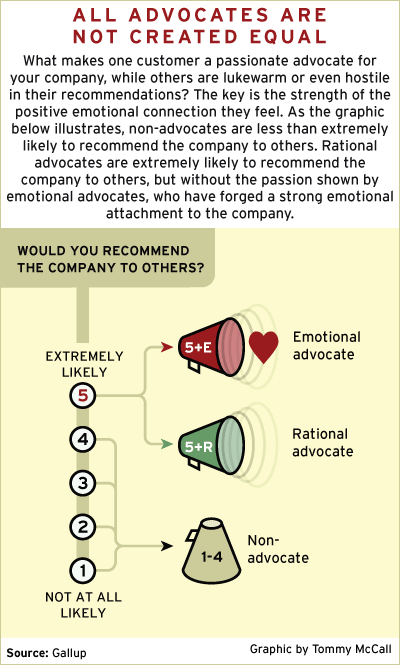 |
To illustrate, let's consider three groups of customers. The first group -- the non-advocates -- is made up of customers who are less than extremely likely to recommend the company to others. The next group -- the rational advocates -- is made up of customers who, while extremely likely to recommend the company to others, lack a strong emotional bond with the company. The final group -- the emotional advocates -- is made up of customers who are also extremely likely to recommend the company to others, but who have forged a strong emotional attachment to the company. (See graphic "All Advocates Are Not Created Equal.")
If advocacy in itself were all that mattered in driving business performance, then we would expect both advocate groups to deliver significantly better business outcomes than the non-advocates. We might not, however, expect the two groups of advocates to differ in their actual behavior toward the company. But according to Gallup research, it doesn't work like that.
First, let's look at the investment behavior of customers of an international private bank. When we sorted the customers into the three categories -- emotional advocates, rational advocates, and non-advocates -- emotional advocates delivered significantly enhanced business outcomes when compared to their rational counterparts, both in share of assets and in the net new assets they invest with the company. Surprisingly, rational advocates do not differ from non-advocates on these key financial measures. (See sidebar "Customer Advocates: The Emotional ROI.")
We found the same general pattern for the customers of an international lodging and hospitality company. In this case, emotional advocates stay more nights and spend more with the company than do their rational counterparts. And they deliver significantly more business value to the company than do rational advocates, who behave more like non-advocates on these key measures. The same general pattern also emerges for a U.S. retailer and a global business-to-business cargo shipper. (See sidebar "Customer Advocates: The Emotional ROI.")
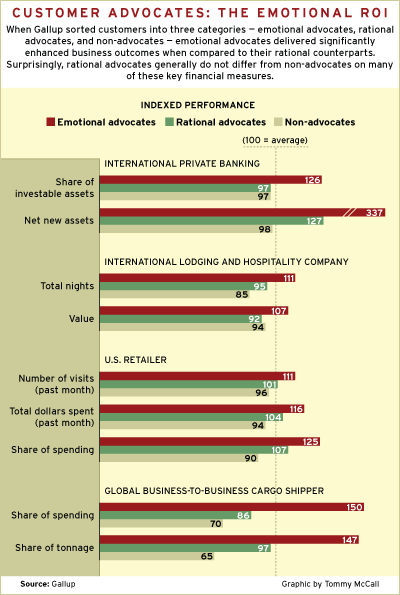 |
Analysis of data from these companies, as well as a host of other companies in the United States and worldwide, demonstrates that a company's strongest advocates behave differently toward the company depending on the degree to which they are emotionally attached to it. If you want to drive advocacy -- and reap the financial benefits that come from building strong emotional connections with your customers -- you must first understand and manage those emotional connections.
Now, obtaining a recommendation from your customers remains crucial to business success. But our research suggests that developing a deep understanding of what makes your customers tick requires more than knowing how many of them would recommend you to others. Human nature is more complicated than that, and business leaders who ignore its complexities do so at their own peril.
Be wary of a single-item approach
There is much of value in Reichheld's analysis of existing customer measurement platforms. There's also much that we agree with -- that traditional customer satisfaction measures are poor indicators of the health of a company's customer relationships, for example, and that only customers giving the highest possible ratings really matter.
However, as noted previously, single-item measures are inherently less reliable, and some advocates are more valuable to your company than others. And there are other reasons to be wary of a single-item approach. Among the most important reasons is that a single-item advocacy metric doesn't tell you why customers recommend a company. As a result, it doesn't give you the intelligence you need to manage customer touchpoints to increase the number of these advocates. Measuring advocacy is one thing, but to manage your customer relationships effectively, you need to know more.
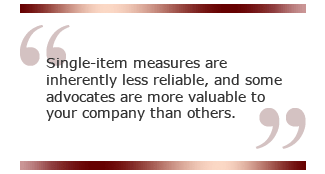 |
For instance, you should probably add questions to your survey to "get under the hood" with your customers, but doing so might undermine the purported value of a single-item measure. And if you need to measure a number of additional factors, you should measure what really matters rather than reducing your set of measures to a single item that struggles to be all things to everyone.
Ultimately, paring down your measurement system to just one question won't obtain the kind of customer feedback you need to drive performance and create organizational change. Instead, you should pay careful attention to exactly what is being measured to ensure that the process balances brevity and simplicity with valid, reliable, and actionable information.
To get inside our customers' heads to understand why they would recommend us to others, we need to first understand their hearts. We need to determine the crucial emotions that channel their experiences and drive their behavior. Our research has revealed that there is a structure to customers' emotional response to the companies they do business with. That structure is remarkably consistent from industry to industry, and it can be both measured and managed.
The four emotional levels
A far-reaching research and development effort reinforced by hundreds of individual company case studies over the past several years has revealed that customers who are engaged with the companies they do business with connect with those companies through four emotional filters or levels.
The first and foundational dimension of emotional attachment is Confidence. Is this company trustworthy? Can they be trusted to do what they say they will do, day in and day out? Have they figured out the basic costs of entry -- the "table stakes" -- to earn my business?
 |
Beyond Confidence lies Integrity, the essential dimension of fair play and fair treatment. Does this company treat them the way they deserve to be treated? If something goes wrong, can they count on this company to fix it fast?
The next emotional requirement is Pride, a sense of positive association and identification with the company. Pride goes well beyond simplistic notions of self-presentational, status, or "badge" qualities of association to deeper levels of shared values between the customer and the company. Customers who feel Pride are proud to be customers not because of what their association with a company says to others, but more importantly, because of what it says to them about themselves. Customers' associations with companies not only convey information about them to others, but they also help define and sharpen their own self-concepts.
The fourth dimension, and the ultimate expression of emotional attachment, is Passion. A passionate customer describes his or her relationship with the company as irreplaceable and a "perfect fit" for them. Passionate customers are rare, but they represent the epitome of customer connectedness. They are customers for life and are worth their weight in gold.
For example, as we noted in a Harvard Business Review article, passionate customers of a luxury retailer spent 44% more annually, on average, than non-passionate customers did. For an international credit card provider, passionate customers used their cards 45% more often and spent 78% more using their cards each month -- revolving significantly larger balances in the process -- than non-passionate customers did. And within the business-to-business realm, passionate customers of a global cargo shipper gave them 39% of their total business compared to 22% among non-passionate customers, an 80% larger share.
Connecting with customers emotionally carries a huge financial benefit. Establishing strong emotional connections with your customers can mean the difference between creating rational advocates -- customers who merely talk about your company -- and emotional advocates -- those who talk about it passionately. And, as mentioned earlier in the article, when measured properly, assessing how engaged your customers are with your company yields a single, simple performance metric that is reliably related to tangible indicators of future business performance.
Variation within companies
There is one final issue that Reichheld's analysis does not cover but that our research has revealed is a key indicator of the health of your company's customer relationships. Reichheld's analysis focuses on performance at the overall company level. But a company's overall performance, regardless of the metric used, often masks the wide variation in performance that exists from location to location or workgroup to workgroup within the company. (See sidebar "Performance Varies by Location.")
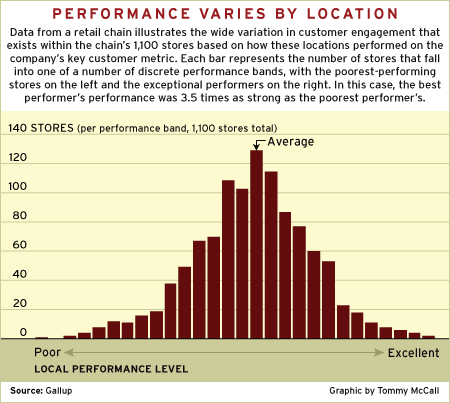 |
Knowing your company's NPS may prove a useful and important piece of business intelligence, but it doesn't tell the whole story. And missing out on the rest of the story can prevent your business from harnessing the true power of customer relationships that drive financial performance.
High-level summary measures, such as averages of the health of a company's customer relationships, may make for useful marketing claims. They may even make executives and managers feel better about their company's overall performance in the marketplace. But because these measures obscure inconsistencies in the quality of those relationships from location to location within the company, they don't provide managers and executives with the information and tools they need to manage effectively and improve performance.
This is crucial because customers experience variation, not averages. The graphic "Performance Varies by Location," for example, shows the variation in customer engagement that exists at the chain's 1,100 stores based on how these locations performed on the company's key customer metric. Each bar represents the number of stores that fall into one of a number of discrete performance bands, with the poorest-performing stores on the left and the exceptional performers on the right. In this case, the best performer's performance was 3.5 times as strong as the poorest performer's.
For most companies, substantial variability in the customer experiences they create represents a significant threat to the sustainability of the enterprise. And the only way to reduce that variability and improve performance is to provide customer feedback at the level within the organization where that variability originates: at the local level where customer interactions occur and the customer experience is created, whether that local level is a store, a bank branch, a local office, or a sales team.
Because most managers' spheres of influence are circumscribed and local, the customer metrics they rely on to manage must also be measured locally. If the customer metric -- like the NPS -- is measured and reported at too high a level, it won't reveal the performance variation that actually exists within the organization. And it won't provide the insight managers and workgroups need to correct and improve customer service.
So go ahead and measure your company's customer advocacy. It's an important piece of information. But while you're at it, don't stop there. Remember that your ultimate goal is to inspire more than mere advocacy among your customers. Your true goal is to inspire passionate advocacy among your customers at every location and touchpoint, because passionate advocacy pays significant financial dividends.
Achieving this goal requires you and your employees to forge strong and lasting emotional bonds with customers. And measuring how effectively you are building and nurturing those emotional bonds is truly the one number you need to grow.
|
Further Reading Crocker, L.M., & Algina, J. (1986). Introduction to classical and modern test theory. New York: Holt Rinehart & Winston. Wanous, J. P., & Hudy, M. J. (2001). Single item reliability: A replication and extension. Organizational Research Methods, 4, 361-375. Wanous, J. P., Reichers, A. E., & Hudy, M. J. (1997). Overall job satisfaction: How good are single-item measures? Journal of Applied Psychology, 82, 247-252. Thurm, S. (2006). One question, and plenty of debate. The Wall Street Journal, December 4, B3. |
